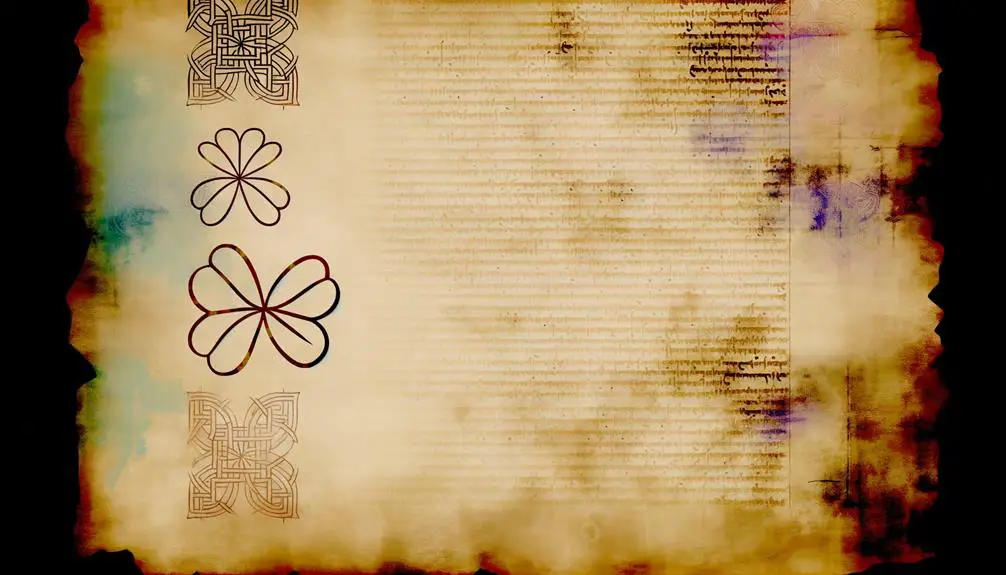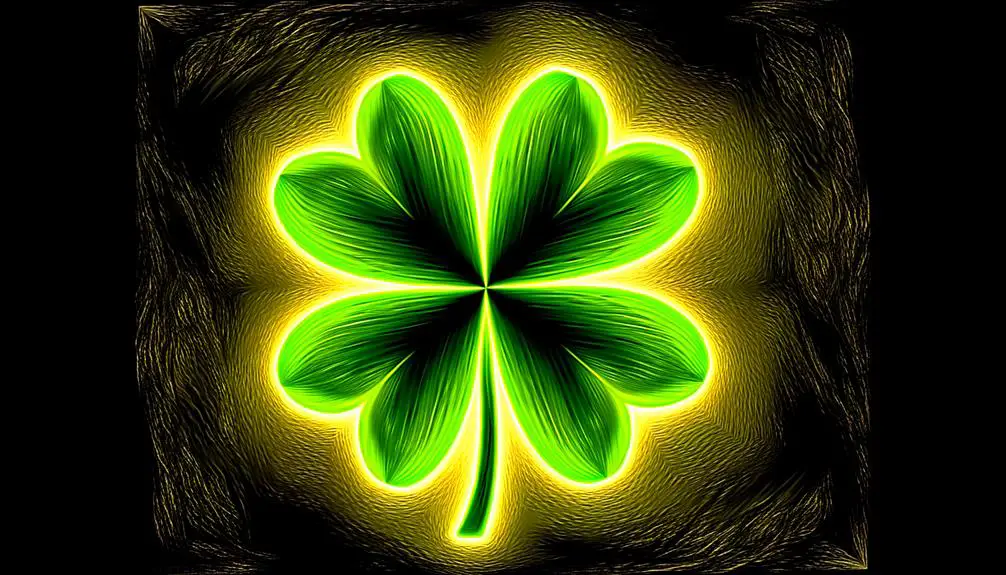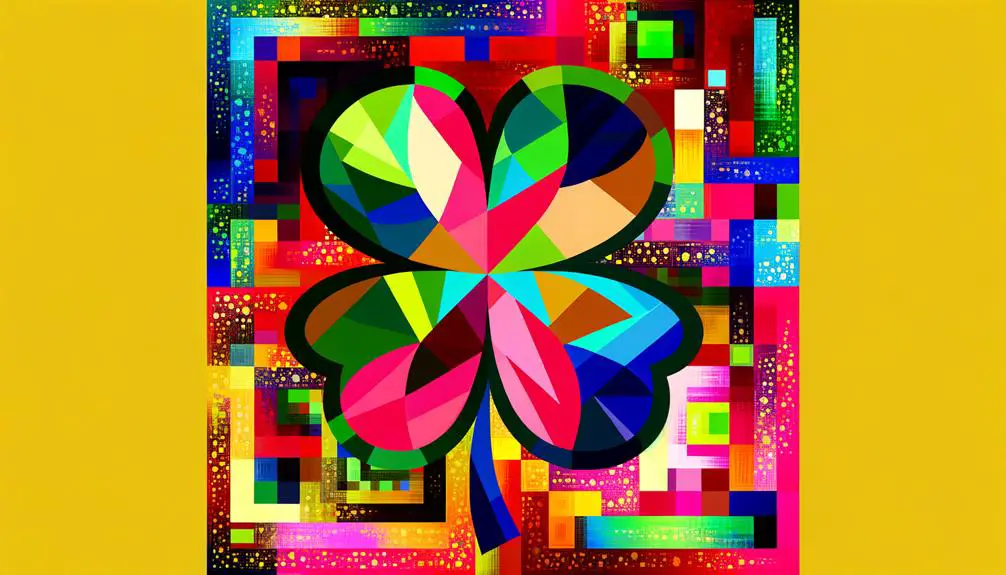What Does the Leaf Clover Symbolize?
The four-leaf clover, deeply rooted in ancient Celtic traditions, symbolizes good fortune, protection, and prosperity. Revered as a rare and powerful talisman by Druids, its significance spans cultures.
In Japanese tradition, its four leaves represent faith, hope, love, and luck. Western societies associate the clover with serendipity and success.
Statistically rare at 1 in 5,000, its leaves are also linked to theological virtues in Christian iconography. Modern interpretations extend its symbolism to personal growth and achieving one's fullest potential through positivity.
Discover more about how this symbol transcends cultural boundaries and historical epochs.

Key Takeaways
- The four-leaf clover symbolizes luck, hope, and prosperity across various cultures.
- Each leaf represents faith, hope, love, and luck.
- In Celtic traditions, it is a powerful talisman offering protection and fortune.
- Statistically rare, its occurrence is about 1 in 5,000, making it a unique find.
- Modern interpretations connect it with personal growth, positivity, and achieving potential.
Origins and History

The origins and history of the four-leaf clover symbol are deeply rooted in ancient Celtic traditions, where it was revered as a rare and powerful talisman believed to bring good fortune and protection.
This botanical anomaly, distinct from the common three-leaf shamrock, held mystical significance. The Druids, Celtic priests of antiquity, considered it a potent symbol of luck, associating its rarity with magical properties. The four leaves were thought to symbolize faith, hope, love, and luck.
Similar beliefs are found in other cultures; for instance, in Japanese tradition, four-leaf clovers are also seen as auspicious, embodying the virtues of faith, hope, love, and luck. Hence, the four-leaf clover's symbolic resonance spans both time and geography, reflecting universal human aspirations.
Cultural Significance
Across various cultures, the four-leaf clover has evolved into a powerful emblem of luck, hope, and prosperity, transcending its botanical rarity to become a symbol of universal human aspiration.
In Celtic traditions, it was believed to offer protection and fortune, reflecting deep-rooted spiritual beliefs.
Japanese culture views the four-leaf clover as an omen of good fortune and happiness, resonating with their intricate connection to nature.
Similarly, in Western societies, it is often associated with serendipity and success, prominently featured in folklore and popular culture.
This cross-cultural reverence underscores a shared yearning for positive outcomes, making the four-leaf clover a potent, enduring symbol across diverse societies.
Its universal appeal attests to humanity's intrinsic hope for betterment and well-being.
Symbolism of the Leaves

Each of the four leaves of the clover is traditionally believed to represent a distinct attribute: faith, hope, love, and luck, encapsulating a holistic view of essential human virtues.
This symbolism is not confined to a single culture; rather, it spans various traditions. In Celtic lore, the four leaves were seen as harbingers of good fortune, embedded deeply in their spiritual ethos.
Similarly, in Christian iconography, the attributes align with theological virtues, suggesting a divine favor. Analyzing its cross-cultural resonance, the clover's leaves serve as a microcosm of universal aspirations, linking human experiences across time and geography.
This multifaceted symbolism underscores the clover's enduring appeal and its layered significance in human consciousness.
Finding a Four-Leaf Clover
Discovering a four-leaf clover amidst a sea of trifoliate clovers is often considered a rare and fortuitous event, steeped in both botanical rarity and cultural mythology.
Statistically, the occurrence of a four-leaf clover is approximately 1 in 5,000, making them a sought-after symbol of luck. Botanically, these clovers are a genetic anomaly, resulting from a recessive gene.
Cross-culturally, four-leaf clovers have been emblematic of good fortune and protection. In Irish tradition, each leaf represents faith, hope, love, and luck. Meanwhile, in Eastern cultures, similar symbols are found in various flora believed to attract prosperity and ward off evil.
The act of finding a four-leaf clover transcends mere chance, embodying a deeper blend of science and superstition.
Modern Interpretations

In contemporary society, the four-leaf clover continues to be revered not only as a symbol of luck but also as an emblem of personal growth and aspiration. It is often integrated into various cultural narratives and modern interpretations of good fortune. This ubiquitous symbol has transcended its folkloric origins, appearing in diverse contexts from corporate branding to self-help literature.
For instance, in Western cultures, it represents serendipitous success, while in Eastern philosophies, it aligns with principles of harmony and balance. Additionally, in the domain of personal development, the four-leaf clover is frequently employed as a metaphor for achieving one's fullest potential through perseverance and positivity. Therefore, its modern interpretations reflect a multifaceted emblem of aspiration and well-being.
Conclusion
The four-leaf clover, with its rare and elusive quality, stands as a timeless symbol of fortune and mystique. Across cultures, it signifies hope, faith, love, and luck, weaving through folklore and history like a lush thread of serendipity.
Modern interpretations continue to honor its appeal, blending ancient beliefs with present-day significance. The delicate yet strong clover leaf remains a tribute to the enduring human fascination with symbols of prosperity and enchantment, deeply rooted in the soil of collective consciousness.






